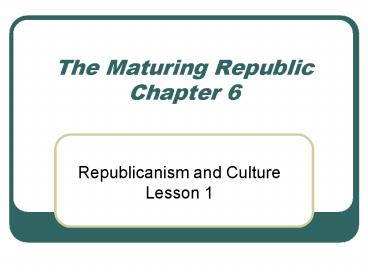The Maturing Republic Chapter 6 - PowerPoint PPT Presentation
1 / 17
Title:
The Maturing Republic Chapter 6
Description:
The Maturing Republic Chapter 6 Republicanism and Culture Lesson 1 What is the American identity today? I. Creation of an American Identity In the early 1800 s ... – PowerPoint PPT presentation
Number of Views:52
Avg rating:3.0/5.0
Title: The Maturing Republic Chapter 6
1
The Maturing RepublicChapter 6
- Republicanism and CultureLesson 1
2
What is the American identity today?
3
I. Creation of an American Identity
- In the early 1800s-America set out to establish
a national identity. - The national identity included the idea of
independence-the right to make their own
decision. - Regardless of this idea, they still allowed the
elite to rule them.
4
- Have you ever wanted to be independent from your
parents? - What kind of freedoms have you gained as you got
older? - In what ways have you expressed your differences
from your parents?
5
The United States and its independence from
England
- It is a natural desire for independence and
self-expression is a natural part of growing up
but it often leads to conflict. - We will learn how the U.S. tried to express this
difference from its parent England.
6
II. Republican ideals and changes
- The household economy- a small, independent
owners of land who grew food for their own
families and for exchange with others within
their community. - This system would build a strong sense of
responsibility to their neighbors and their
communitys needs.
7
- C. Washington becomes a classical hero when in
1800 Mason Weems writes a - biography portraying Washington as the perfect
republican. - What stories do you remember?
- D. Classical art and architecture were adopted
from the ancient Greeks and Romans. They began to
pattern buildings after this style known as
neo-classicalism or a new classical style.
8
Neoclassical or Rococo
9
Neoclassical or Rococo?
10
Neoclassical or Rococo?
11
- E. Women were not allowed to vote or hold office.
The only role they were allowed - was motherhood. Women were to be patriotic and
instill this into their families. This was known
as republican motherhood.
12
III. The New Individualism
- A. Many began to move westward and pioneers
settled in Kentucky and Tennessee in the 1790s. - B. People began to explore the Old Northwest
Ohio, Indiana, Illinois, Michigan, and Wisconsin.
Others moved into the Old Southwest Alabama,
Mississippi, and Louisiana.
13
- C. This was facilitated by better transportation
networks built by the state government. - D. The national road was begun under President
Jefferson. - E. A series of canal systems linked lakes and
rivers which made shipping easier and cheaper. - F. These changes brought a great increase in
trade and aided the growth a market
economy-people selling goods to distant markets
to be sold for cash. This eventually replaced the
household economy. - G. Individual material success became more
important than the communities.
14
IV. Values in Conflict
- The ideal of the self-made man grew out of
individualism. - Both religion and politics began to reflect the
conflict between the wish for personal gain and
the need to sacrifice for the good of the
community.
15
V. The Second Great Awakening
- Followed the first 70 years before.
- Church membership had gone down during the
Revolutionary War and the churches wanted them
back. - All denominations of Christianity Anglicans,
Puritans, Presbyterians, Quakers, Lutherans, and
Baptists gained members. Black churches
especially grew. - Inspired members to become missionaries and to
educate the poor such as the American Indians,
Hawaii, and China. - Women found a role and formed female
organizations to spread the religious message.
16
VI. Expansion of Political Rights
- Protestants renewed their faith in the movement
while Jews and Christians gained political
rights. - Beginning with Virginia, state after state struck
down the old practice of supporting churches with
tax money. - Laws that discriminated against people because of
their religion were changed. - Tolerance of religion began to grow.
17
- E. Barriers to suffrage (the right to vote) were
removed for white males. - F. Some states no longer required voters to be
own land. These men sought political power once
held by the elite. - G. They were looked down upon by the old
republicans and called them coonskin
Congressman. - H. The new politician listened to the publics
opinion and voter rewarded them with their
support.































